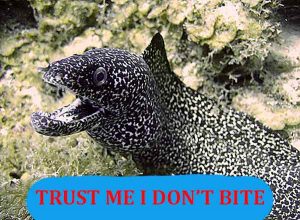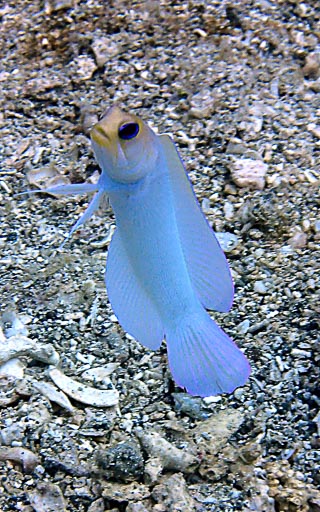“Trust Me” dives, the problems with Divemaster led dives
Don’t fall into the habit of relying on your Divemaster for everything
Vacation dives, led by a divemaster are the only type of dives that many divers actually do.
Many of these dives become “Trust Me” dives and a lot of divers just don’t appreciate the dangers when a regular “please show me the cool stuff” type of dive becomes a “Trust Me” dive.
So what do we mean about a “Trust Me” dive and is it a good or bad thing?
Definition of a Trust Me Dive
A “trust me” dive occurs every time another diver, (dive buddy or professional) takes a less experienced diver into a dive situation where the following applies:
- The less experienced diver, if separated, is unlikely to have the skills to safely end the dive on their own. (This particularly applies to deeper dives and overhead environments).
- The less experienced diver does not understand the risk factors of the dive because “they don’t know what they don’t know”.
- Risks cannot be assessed and mitigated if you don’t understand what the risks are.
- The inexperienced diver is diving outside the limits of their training and experience and would NOT be comfortable doing the dive independently with a buddy of similar experience.

During training you were advised to dive within the current limitations of your experience.
As you build experience and practice your skills you extend your limitations and slowly become more competent.
This results in a gradual build up of your skills and the development of the correct mindset.
This mindset allows you to dive in tougher conditions, possibly deeper BUT you rely on your own skill set to do this, not the skill set of your dive buddy.
Divers in a team need to trust each other, but this trust is mutual, not one sided.
Trust me dives are a bad idea because:
- When things go wrong, accidents can and do happen.
- They encourage divers to overestimate their own abilities.
- The less experienced diver does not have the knowledge and skills to deal with any emergency or contingency which may arise.
A dive led by a good dive professional is not a “Trust Me” dive.
You are on vacation, you don’t know the area, you dive with a group led by a Divemaster.
This is a very common scenario and this is not a ‘Trust Me” dive because you are still responsible for the following:
- Checking your own gear (even if it is rental gear).
- Ensuring that the dive as briefed is within your capabilities/experience.
- Adhering to the buddy system.
- Following the dive plan as outlined by the dive leader and adding your own air limitations, NDL limitations and contingency planning to the dive plan that you and your buddy decide upon.
- Deciding “AM I SAFE TO DIVE”, on the day, in the conditions, following the dive plan.
This scenario only becomes ‘Trust Me” dive if you are one of those divers who decide that having professional supervision means they can “opt out” of responsible decision making.
What is the dive leader responsible for?
- Planning a dive for their group that is within the capabilities of the divers considering the dive conditions on the day.
But if you don’t communicate with your dive leader then they will not know your concerns. (Read about diver communication here) - Briefing all divers thoroughly on the dive plan.
- Briefing all divers on entry / exit / descent procedures, air monitoring procedures, maximum depth for the dive and everything regarding general safety for the dive.
- A good leader will probably include a reminder about checking gear, safety stops, signals, lost buddy procedure and other things that you should already know, because a reminder never hurts.
- A good leader will tell you about cool things to look for on the dive and any marine hazards you should avoid.
What is the dive leader NOT responsible for?
- A dive leader is not there to babysit you and your buddy, (if you need this you should hire your own personal guide and not go with the group).
- A dive leader is not there to make sure you don’t run out of air, that is your responsibility.
- A dive leader is not there to make sure you don’t exceed your personal maximum depth, the dive has been planned to give you the opportunity to stay within your comfort depth, it is up to you to do so.
- A dive leader is not there to make sure you don’t ascend too fast or blow through your safety stop.
Once you abdicate your responsibility for the above, you are in a “Trust Me“ situation.
Obviously a good dive leader is going to do their best to ensure nothing bad happens but you cannot hold them responsible if you and your buddy get separated from the group or you get so low on air that you finish the dive swimming on the surface back to the boat.
Remember they have an entire group of divers to lead, they cannot concentrate on a single buddy pair.
Instructor / Student Training dives
If you are on a training course with an instructor then obviously you are trusting the instructor to ensure the course is conducted safely.
However this scenario differs greatly from the above for the following reasons.
- The risk management for the dive has been thoroughly discussed and you understand this.
- You have the knowledge to conduct the dive safely and in the instructors judgement you have the basic skills. These skills we will be developing during the dive.
- We have a solid dive plan, written on a slate if necessary.
- We have a solid gas plan, again written down, especially for any dive below 60 ft.
- All equipment being used for the dive has been checked.
- We both understand that you accept equal responsibility for your diving safety.
A true story
Many years ago, before I was an Instructor, I was on vacation in the Dominican Republic.
The dive leader briefed going through a series of tunnels as part of the dive.
Having done some overhead training I asked if all these were wide enough for a buddy pair travelling side by side. His answer to my question was “don’t worry about that, they are only 50 ft deep”.
Every diver, including the leader was using single tank and standard octo hose (no long hoses in sight), so impossible to go “head to toe” through a narrow gap in an air failure situation.
My “insta-buddy” was thoroughly excited by the prospect.
In private I told the dive leader that I was not comfortable going through any narrow tunnels on this dive, his response “well if you want to wuss out on the best part of the dive, just go over the top, if you get lost it won’t be my fault”
I communicated the same to my buddy and suggested he find someone else who was willing to dive the tunnels.
The outcome, the tunnel entrances were too narrow for two divers, my buddy went through on his own, I went over the top and did not get lost.
Ultimately every diver returned safely but you can see how the Dive Leader turned this into a ‘Trust Me” dive.
The consequences of a hose blowing in one of those tunnels really does not bear thinking about.











